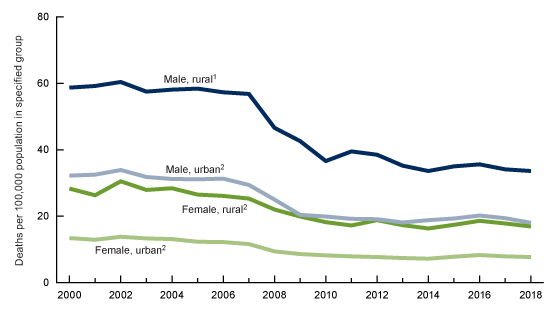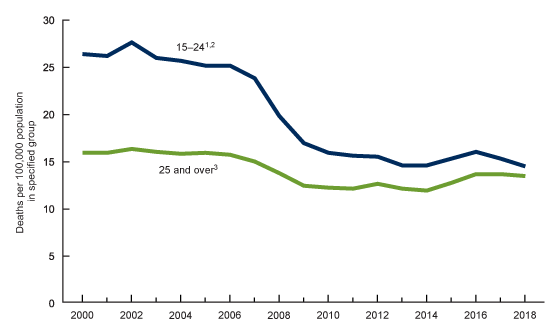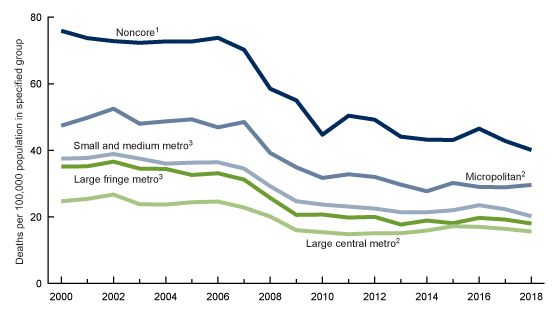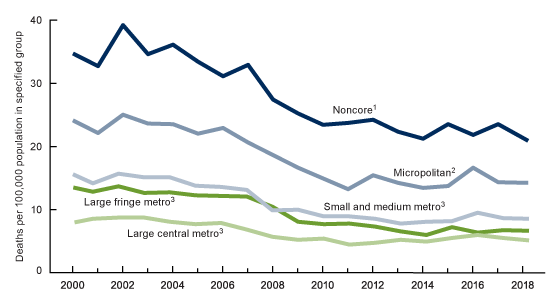Motor Vehicle Traffic Death Rates Among Adolescents and Young Adults Aged 15–24, by Urbanicity: United States, 2000–2018
- Key findings
- MVT death rates for persons aged 15–24 varied over time but generally declined between 2000 and 2018.
- MVT death rates were about twice as high in rural than urban areas for both males and females.
- From 2000 to 2018, MVT death rates for males aged 15–24 were highest in the most rural areas and lowest in most urban areas.
- From 2000 to 2018, MVT death rates for females aged 15–24 were highest in the most rural areas and lowest in most urban areas.
- Summary
- Data source and methods
- About the authors
- References
- Suggested citation
PDF Version (703 KB)
Key findings
Data from the National Vital Statistics System (NVSS)
- The death rate due to motor vehicle traffic (MVT) injury for persons aged 15–24 was stable from 2000 to 2006, declined 36% from 2006 (25.1 per 100,000) to 2010 (16.1), and then was stable through 2018 (14.7).
- Over the 2000–2018 period, MVT death rates for males aged 15–24 in rural areas were about twice those of males in urban areas; similarly, rates were twice as high for females in rural rather than urban areas.
- Although males aged 15–24 residing in the most rural counties (noncore) had the highest MVT death rate of all urbanicity groups, the rate significantly declined from 2006 to 2018.
- MVT death rates for females aged 15–24 were highest in the most rural counties (noncore) and lowest in the most urban counties (large central metro) throughout the entire period.
Deaths due to motor vehicle traffic (MVT) injury are a leading cause of death for adolescents and young adults aged 15–24, with death rates higher than for adults aged 25 and over (1). Adolescent and young adult drivers are less experienced, and they tend to be passengers in cars with less experienced drivers (2). This report presents trends in death rates due to MVT among persons aged 15–24 from 2000 to 2018 by sex, urban-rural classification, and urbanicity of county of residence.
Keywords: death certificates, traffic accidents, National Vital Statistics System
MVT death rates for persons aged 15–24 varied over time but generally declined between 2000 and 2018.
- In 2018, the MVT death rate for persons aged 15–24 was 14.7 per 100,000, which was 7% higher than the rate for persons aged 25 and over (13.7). This difference narrowed from 2000 when the difference in rates was 63% (26.3 compared with 16.1) (Figure 1).
- Death rates due to MVT injury for persons aged 15–24 and 25 and over were stable from 2000 to 2006 but then declined 36% from 2006 to 2010 for those aged 15–24 (from 25.1 per 100,000 to 16.1) and 21% for those aged 25 and over (from 15.9 to 12.5).
- From 2010 to 2018, rates were stable for persons aged 15–24 but increased 10% among those 25 and over.
Figure 1. Motor vehicle traffic death rates among persons aged 15–24 and 25 and over: United States, 2000–2018
1Stable trend from 2000 to 2006; significant decreasing trend from 2006 to 2010; stable trend from 2010 to 2018; p < 0.05.
2Rate for persons aged 15–24 from 2000 to 2018 was significantly higher than for persons aged 25 and over, p < 0.05.
3Stable trend from 2000 to 2006; significant decreasing trend from 2006 to 2010; significantly increasing trend from 2010 to 2018; p < 0.05.
NOTES: Motor vehicle traffic injuries are identified with International Classification of Disease, 10th Revision (ICD–10) codes (V02–V04[.1,.9], V09.2, V12–V14[.3–.9], V19[.4–.6], V20–V28[.3–.9], V29–V79[.4–.9], V80[.3–.5], V81.1, V82.1, V83–V86[.0–.3], V87[.0–.8], and V89.2). Access data table for Figure 1.
SOURCE: National Center for Health Statistics, National Vital Statistics System, Mortality.
MVT death rates were about twice as high in rural than urban areas for both males and females.
- The MVT death rate for males in rural areas was stable from 2000 to 2007 and then declined 41% from 2007 (56.8) to 2018 (33.6). The rate declined by an average of 13.6% annually from 2007 (56 .8) to 2010 (36.6), and by an average of 1.4% annually from 2010 (36.6) to 2018 (33.6) (Figure 2).
- Death rates due to MVT for males in urban areas were stable from 2000 (32.2) to 2006 (31.3), declined 36% from 2006 to 2010 (19.9), and then remained stable through 2018 (18.0).
- Females in urban and rural areas had similar trends in their MVT death rates over the period—rates declined slightly but nonsignificantly from 2000 to 2006, declined by about one-third from 2006 to 2010, (from 12.2 to 8.2 for urban and from 26.1 to 18.2 for rural) and then were stable from 2010 to 2018.
- MVT death rates for males in rural areas were about twice those of males in urban areas over the entire 2000 to 2018 period. Similarly, rates for females in rural areas were about twice those of females in urban areas.
Figure 2. Motor vehicle traffic death rates among persons aged 15–24, by sex and urban-rural classification: United States, 2000–2018

1Stable trend from 2000 to 2007; significant decreasing trend from 2007 to 2018 with different rates of change over time; p < 0.05.
2Stable trend from 2000 to 2006; significant decreasing trend from 2006 to 2010; stable trend from 2010 to 2018; p < 0.05.
NOTES: Motor vehicle traffic injuries are identified with International Classification of Disease, 10th Revision (ICD–10) codes (V02–V04[.1,.9], V09.2, V12–V14[.3–.9], V19[.4–.6], V20–V28[.3–.9], V29–V79[.4–.9], V80[.3–.5], V81.1, V82.1, V83–V86[.0–.3], V87[.0–.8], and V89.2). Urbanicity of county of residence is based on the 2013 NCHS Urban-Rural Classification Scheme for Counties; see Data source and methods. In 2018, death rates for rural areas were significantly higher than for urban areas for both males and females, p < 0.05. Access data table for Figure 2.
SOURCE: National Center for Health Statistics, National Vital Statistics System, Mortality.
From 2000 to 2018, MVT death rates for males aged 15–24 were highest in the most rural areas and lowest in most urban areas.
- The MVT death rate for males aged 15–24 in the most rural counties (noncore) was stable from 2000 to 2006, and then declined 46% from 2006 (73.8) to 2018 (40.1) at an average of 13.1% annually from 2007 to 2010 and 1.7% annually from 2010 to 2018 (Figure 3).
- All urbanicity groups except the most rural (noncore) had similar MVT death rate trends for males aged 15–24 from 2000 to 2018—rates were stable from 2000 to 2006–2007, declined 34%–37% through 2010, and then leveled off through 2018.
- MVT death rates for males aged 15–24 decreased with increasing urbanicity. In 2018, the rate for the most rural (noncore) counties (40.1) was 2.6 times higher than the rate for the most urban (large central metro) counties (15.6).
Figure 3. Motor vehicle traffic death rates among males aged 15–24, by urbanicity of county of residence: United States, 2000–2018
1Stable trend from 2000 to 2007; significant decreasing trend from 2007 to 2018 with different rates of change over time; p < 0.05.
2Stable trend from 2000 to 2007; significant decreasing trend from 2007 to 2010; stable trend from 2010 to 2018; p < 0.05.
3Stable trend from 2000 to 2006; significant decreasing trend from 2006 to 2010; stable trend from 2010 to 2018; p < 0.05.
NOTES: Motor vehicle traffic injuries are identified with International Classification of Disease, 10th Revision (ICD–10) codes (V02–V04[.1,.9], V09.2, V12–V14[.3–.9], V19[.4–.6], V20–V28[.3–.9], V29–V79[.4–.9], V80[.3–.5],V81.1,V82.1,V83–V86[.0–.3], V87[.0–.8], and V89.2). Urbanicity of county of residence is based on the 2013 NCHS Urban-Rural Classification Scheme for Counties; see Data source and methods. In 2018, death rates for all urbanicity groups were significantly different from each other, p < 0.05. Access data table for Figure 3.
SOURCE: National Center for Health Statistics, National Vital Statistics System, Mortality.
From 2000 to 2018, MVT death rates for females aged 15–24 were highest in the most rural areas and lowest in most urban areas.
- The MVT death rate for females aged 15–24 in the most rural counties (noncore) was stable from 2000 to 2004 and then declined 35% from 2004 (36.2) to 2010 (23.5). The rate then leveled off through 2018 (Figure 4).
- All urbanicity groups except the most rural (noncore) had similar MVT death rate trends for females aged 15–24 from 2000 to 2018—rates were stable from 2000 to 2006, declined 30%–42% through 2010–2011, and then leveled off through 2018.
- MVT death rates for females aged 15–24 decreased with increasing urbanicity. In 2018, the rate for the most rural (noncore) counties (21.4) was 3.6 times higher than the rate for the most urban (large central metro) counties (5.9).
Figure 4. Motor vehicle traffic death rates among females aged 15–24, by urbanicity of county of residence: United States, 2000–2018
1Stable trend from 2000 to 2004; significant decreasing trend from 2004 to 2010, stable trend from 2010 to 2018; p < 0.05.
2Stable trend from 2000 to 2006; significant decreasing trend from 2006 to 2011, stable trend from 2011 to 2018; p < 0.05.
3Stable trend from 2000 to 2006; significant decreasing trend from 2006 to 2010, stable trend from 2010 to 2018; p < 0.05.
NOTES: Motor vehicle traffic injuries are identified with International Classification of Disease, 10th Revision (ICD–10) codes
(V02–V04[.1,.9], V09.2, V12–V4[.3–.9], V19[.4–.6], V20–V28[.3,.9], V29–V79[.4–.9], V80[.3–.5], V81.1, V82.1, V83–V86[.0–.3], V87 [.0–.8], and V89.2). Urbanicity of county of residence is based on the 2013 NCHS Urban-Rural Classification Scheme for Counties; see Data source and methods. In 2018, death rates for all urbanicity groups were significantly different from each other, p < 0.05. Access data table for Figure 4.
SOURCE: National Center for Health Statistics, National Vital Statistics System, Mortality.
Summary
MVT death rates for persons aged 15–24 and those aged 25 and over had similar trends from 2000 to 2010, an initial stable period and then declines of 36% and 21%, respectively. Beginning in 2010, rates for those aged 15–24 remained stable whereas rates for those 25 and over increased 10%. Thus, the difference in rates narrowed over the period, from 63% higher for persons aged 15–24 in 2000 to 7% higher in 2018.
MVT death rates for persons aged 15–24 were highest among males in rural areas. However, rural males aged 15–24 were the only group that had a significant decline from 2007 to 2018. Rates for males in the other urbanicity groups and females, regardless of urbanicity, leveled off in more recent years.
For both males and females, those in the most rural areas (noncore) had higher rates than all other urbanicity areas, and rates consistently declined with increasing urbanicity. In 2018, MVT death rates for males residing in the most rural (noncore) counties were 2.6 times the rates for those residing in the most urban (large central metro) counties (40.1 compared with 15.6); likewise, MVT death rates for females in 2018 were 3.6 times higher for those in noncore counties than in large central metro counties (21.4 compared with 5.9).
Data source and methods
Mortality and population data are from the National Center for Health Statistics’ 1999–2018 underlying cause-of-death mortality files (CMF) (3). MVT deaths were identified using International Classification of Diseases, 10th Revision (ICD–10) underlying cause-of-death codes V02–V04[.1,.9], V09.2, V12–V14[.3–.9], V19[.4–.6], V20–V28[.3,.9], V29– V79[.4–.9], V80[.3–.5], V81.1, V82.1, V83–V86[.0–.3], V87[.0–.8], and V89.2 (4). Death rates for each year were calculated using the total number of MVT deaths to persons aged 15–24 as the numerator and dividing by the population in that age group and multiplying by 100,000. Population data for 2000 and 2010 are April 1 bridged-race census counts, for 2001–2009 they are July 1 intercensal estimates, and for 2011–2018 they are July 1 postcensal estimates based on the 2010 census.
Urbanization level of the decedent’s county of residence was categorized using the 2013 National Center for Health Statistics Urban–Rural Classification Scheme for Counties (5). In this scheme, counties are classified into six urbanization levels based primarily on metropolitan–nonmetropolitan status and population distribution. Metropolitan counties include large central counties, the fringes of large counties (suburbs), medium counties, and small counties. Nonmetropolitan counties include micropolitan statistical areas and noncore areas, including open countryside, rural towns (populations of less than 2,500), and areas with populations of 2,500–49,999 that are not part of larger labor market areas. In this report, the urban or rural classification in Figure 2 was based on the following groupings: the urban classification contains the four metropolitan groups of large central, large fringe, medium and small metro; the rural classification contains the two nonmetropolitan groups of micropolitan and noncore. In Figures 3 and 4, which contain the detailed urbanicity groups, the medium and small metro groups were combined to simplify the findings.
Trends in MVT death rates in Figures 1–4 were evaluated using the Joinpoint Regression Program (6). The Joinpoint software was used to fit weighted least-squares regression models to the estimated proportions on the logarithmic scale. The default settings allowed for as few as three observed time points in the beginning, ending, and middle line segments, including the joinpoints. Using these settings, a maximum of three joinpoints were searched for using the grid search algorithm and permutation test, and an overall alpha level of 0.05. Pairwise comparisons between gender, urban or rural classification, and urbanicity of county were tested using the z test statistic at the 0.05 level of significance.
About the authors
Sally C. Curtin and Betzaida Tejada-Vera are with the National Center for Health Statistics, Division of Vital Statistics.
References
- Kochanek KD, Murphy SL, Xu JQ, Arias E. Deaths: Final data for 2017. National Vital Statistics Reports; vol 68 no 9. Hyattsville, MD: National Center for Health Statistics. 2019.
- Young drivers: 2017 data. (Traffic Safety Facts. Report no DOT HS 812 753). National Center for Statistics and Analysis. Washington, DC: National Highway Traffic Safety Administration. 2019.
- National Center for Health Statistics. Underlying cause of death, 1999–2018. CDC WONDER online database. 2016.
- World Health Organization. International statistical classification of diseases and related health problems, 10th revision (ICD–10). 2008 ed. Geneva, Switzerland. 2009.
- Ingram DD, Franco SJ. 2013 NCHS urban–rural classification scheme for counties. National Center for Health Statistics. Vital Health Stat 2(166). 2014.
- National Cancer Institute. Joinpoint Regression Program (Version 4.7.0.0) [computer software]. 2019.
Suggested citation
Curtin SC, Tejada-Vera B. Motor vehicle traffic death rates among adolescents and young adults aged 15–24, by urbanicity: United States, 2000–2018. NCHS Data Brief, no 385. Hyattsville, MD: National Center for Health Statistics. 2020.
Copyright information
All material appearing in this report is in the public domain and may be reproduced or copied without permission; citation as to source, however, is appreciated.
National Center for Health Statistics
Brian C. Moyer, Ph.D., Director
Amy M. Branum, Ph.D., Acting Associate Director for Science
Division of Vital Statistics
Steven Schwartz, Ph.D., Director
Isabelle Horon, Dr.P.H., Acting Associate Director for Science


